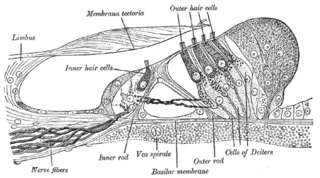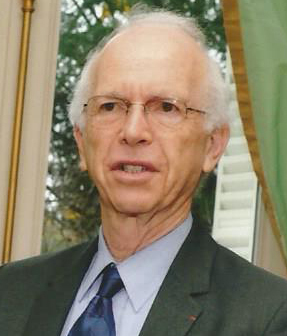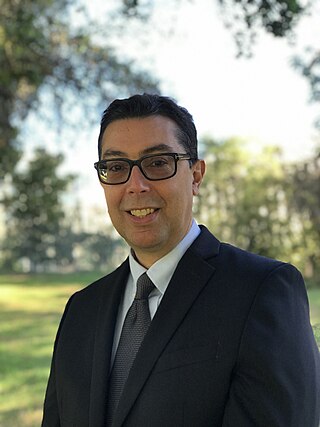
The inner ear is the innermost part of the vertebrate ear. In vertebrates, the inner ear is mainly responsible for sound detection and balance. In mammals, it consists of the bony labyrinth, a hollow cavity in the temporal bone of the skull with a system of passages comprising two main functional parts:

The cochlea is the part of the inner ear involved in hearing. It is a spiral-shaped cavity in the bony labyrinth, in humans making 2.75 turns around its axis, the modiolus. A core component of the cochlea is the organ of Corti, the sensory organ of hearing, which is distributed along the partition separating the fluid chambers in the coiled tapered tube of the cochlea.

The basilar membrane is a stiff structural element within the cochlea of the inner ear which separates two liquid-filled tubes that run along the coil of the cochlea, the scala media and the scala tympani. The basilar membrane moves up and down in response to incoming sound waves, which are converted to traveling waves on the basilar membrane.

The organ of Corti, or spiral organ, is the receptor organ for hearing and is located in the mammalian cochlea. This highly varied strip of epithelial cells allows for transduction of auditory signals into nerve impulses' action potential. Transduction occurs through vibrations of structures in the inner ear causing displacement of cochlear fluid and movement of hair cells at the organ of Corti to produce electrochemical signals.

The auditory system is the sensory system for the sense of hearing. It includes both the sensory organs and the auditory parts of the sensory system.

Hair cells are the sensory receptors of both the auditory system and the vestibular system in the ears of all vertebrates, and in the lateral line organ of fishes. Through mechanotransduction, hair cells detect movement in their environment.

Carlos José Bustamante is a Peruvian-American scientist. He is a member of the National Academy of Sciences.
Ernest Charles "Ernie" Pollard was a British professor of physics and biophysics and an author, who worked on the development of radar systems in World War II, worked on the physics of living cells, and wrote textbooks and approximately 200 papers on nuclear physics and radiation biophysics.

Prestin is a protein that is critical to sensitive hearing in mammals. It is encoded by the SLC26A5 gene.

The tectoria membrane (TM) is one of two acellular membranes in the cochlea of the inner ear, the other being the basilar membrane (BM). "Tectorial" in anatomy means forming a cover. The TM is located above the spiral limbus and the spiral organ of Corti and extends along the longitudinal length of the cochlea parallel to the BM. Radially the TM is divided into three zones, the limbal, middle and marginal zones. Of these the limbal zone is the thinnest (transversally) and overlies the auditory teeth of Huschke with its inside edge attached to the spiral limbus. The marginal zone is the thickest (transversally) and is divided from the middle zone by Hensen's Stripe. It overlies the sensory inner hair cells and electrically-motile outer hair cells of the organ of Corti and during acoustic stimulation stimulates the inner hair cells through fluid coupling, and the outer hair cells via direct connection to their tallest stereocilia.
Thomas Dean Pollard is a prominent educator, cell biologist and biophysicist whose research focuses on understanding cell motility through the study of actin filaments and myosin motors. He is Sterling Professor Emeritus of Molecular, Cellular & Developmental Biology and a professor emeritus of cell biology and molecular biophysics & biochemistry at Yale University. He was dean of Yale's Graduate School of Arts and Sciences from 2010 to 2014, and president of the Salk Institute for Biological Studies from 1996 to 2001.
The cochlear amplifier is a positive feedback mechanism within the cochlea that provides acute sensitivity in the mammalian auditory system. The main component of the cochlear amplifier is the outer hair cell (OHC) which increases the amplitude and frequency selectivity of sound vibrations using electromechanical feedback.

Jonathan Felix Ashmore is a British physicist and Bernard Katz Professor of Biophysics at University College London.

Stuart J. Edelstein is a biophysicist, emeritus professor from the University of Geneva, professeur extraordinaire at the École Normale Supérieure and visiting scientist at the Babraham Institute.
Peter Dallos is the John Evans Professor of Neuroscience Emeritus, Professor Emeritus of Audiology, Biomedical Engineering and Otolaryngology at Northwestern University. His research pertained to the neurobiology, biophysics and molecular biology of the cochlea. This work provided the basis for the present understanding of the role of outer hair cells in hearing, that of providing amplification in the cochlea. After his retirement in 2012, he became a professional sculptor.

A. James Hudspeth is the F.M. Kirby Professor at Rockefeller University in New York City, where he is director of the F.M. Kirby Center for Sensory Neuroscience. His laboratory studies the physiological basis of hearing.
Barry H. Honig is an American biochemist, molecular biophysicist, and computational biophysicist, who develops theoretical methods and computer software for "analyzing the structure and function of biological macromolecules."
Lorin John Mullins was an American biophysicist who researched the movement of ions across the cell membrane. He served as the editor of the Annual Review of Biophysics and Bioengineering for ten years.
G.V. Shivashankar is an Indian biophysicist working in the field of Mechanobiology. His research focuses on understanding the coupling between cell mechanics and genome organization for the regulation of cell homeostasis and cell state transitions. In addition his group also developed imaging-AI based chromatin biomarkers as fingerprints for cells in health and disease. Towards this, his group employs multi-scale correlative bio-imaging methods combined with bioengineered interfaces, functional genomics, theoretical modeling, and machine learning. He currently holds a full professorship for Mechano-Genomics at the Department of Health Sciences and Technology at ETH Zurich and he also heads the Laboratory of Nanoscale Biology at the Paul Scherrer Institute.

John Oghalai is an American physician and scientist. He is the Leon J. Tiber and David S. Alpert Chair in Medicine at the University of Southern California Keck School of Medicine and chair of the USC Caruso Department of Otolaryngology. Oghalai is an otolaryngologist. His research focuses on anatomical and molecular mechanisms in hearing and in ear and hearing disorders.










